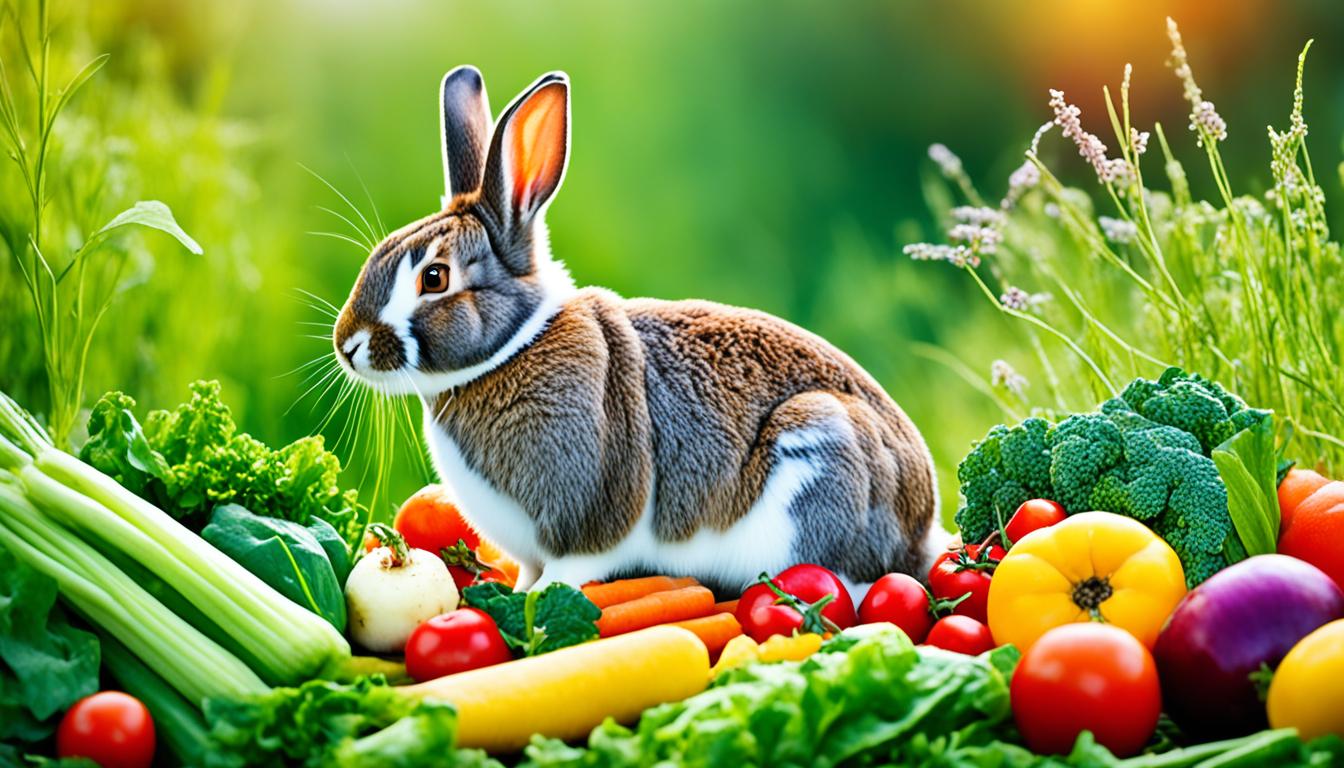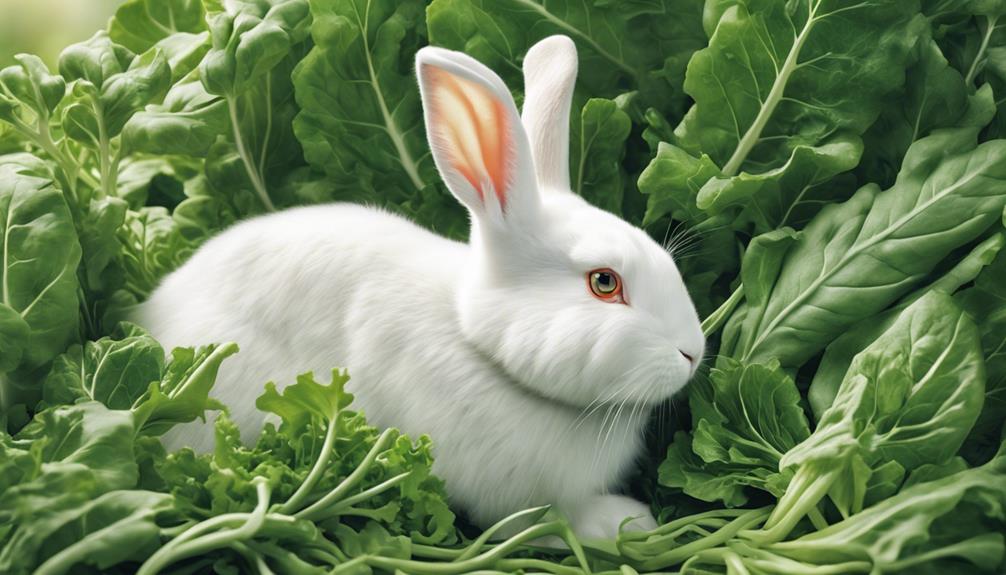Did you know that rabbits are the third most popular pet in the United States, with over 6 million rabbit owners? These cute animals have won over many hearts, but taking care of and training them requires a certain level of knowledge and understanding. Whether you’re a new rabbit owner or have been caring for bunnies for years, this ultimate rabbits guide is here to offer expert advice and useful tips on how to properly care for and train your fluffy companion.
Key Takeaways:
- Learn the importance of proper care and the commitment required for rabbits.
- Understand the ideal diet for rabbits, including the significance of hay, leafy greens, and pellets.
- Provide a spacious enclosure for your rabbit and ensure they get daily exercise.
- Discover the best practices for introducing and bonding rabbits together.
- Gain insights into rabbit behavior, grooming, and creating a rabbit-safe environment.
The Importance of Proper Rabbit Care
Contrary to popular belief, rabbits are not low-maintenance pets. They require dedicated care and attention, similar to dogs and cats. It is a long-term commitment that involves providing a healthy diet, a spacious enclosure, social enrichment, litter training, grooming, and regular veterinary check-ups. The well-being of your pet rabbits should be a top priority in order to ensure their happiness and longevity.
Providing a Healthy Diet
Proper nutrition is essential for the overall health of your rabbits. A well-balanced diet consists of high-quality hay, fresh vegetables, and a limited amount of pellets. Hay, such as Timothy hay, is the most important component of their diet as it provides the necessary fiber for good digestion and dental health. Fresh leafy greens, like romaine lettuce and spinach, should also be included to provide additional nutrients. However, it’s important to avoid feeding rabbits foods that are toxic or harmful to them, such as chocolate, caffeine, and onions.
Creating a Spacious Enclosure
Rabbits need ample space to exercise and explore. A small cage is not suitable for long-term housing. Instead, opt for a spacious enclosure that allows them to hop, run, and stretch their legs. Aim for a minimum enclosure size of 4ft by 2ft for an average-sized rabbit. Additionally, rabbits should have supervised access to a larger area for exercise outside of their enclosure, such as a playpen or a rabbit-proofed room in your home.
Providing Social Enrichment
Rabbits are social animals and require social interaction and mental stimulation. Spending quality time with your rabbits, providing toys, and engaging them in interactive play can help prevent boredom and promote a healthy and happy rabbit. Toys such as tunnels, chew toys, and puzzle toys can help keep them entertained. Additionally, rabbits can benefit from the companionship of another rabbit, as long as proper introductions and bonding techniques are followed.
Litter Training and Grooming
Litter training is essential for keeping your rabbit’s living space clean and hygienic. Rabbits can be trained to use a litter box just like cats. By placing a litter box in a designated area and using positive reinforcement, you can teach your rabbit to use the litter box consistently.
Regular grooming is important for maintaining your rabbit’s health and well-being. They have a tendency to groom themselves but may need assistance in removing excess fur and preventing fur matting. Regular brushing and nail trimming should be part of their grooming routine to keep them comfortable and prevent any health issues.
Regular Veterinary Check-ups
Just like any other pet, rabbits require regular veterinary check-ups to ensure they are healthy. Schedule routine visits with a rabbit-savvy veterinarian to monitor their overall health, examine their teeth, and address any potential health concerns. Early detection of illnesses and preventive care are crucial in ensuring your rabbits lead a long and happy life.
Proper care and attention are essential to ensure the well-being and happiness of your pet rabbits. By providing a healthy diet, a spacious enclosure, social enrichment, litter training, grooming, and regular veterinary check-ups, you are guaranteeing a long and fulfilling life for your furry companions.
Understanding the Rabbit Diet
A healthy diet is crucial for the well-being of rabbits. By providing them with the right balance of nutrients, you can ensure their overall health and happiness. Understanding the components of a rabbit’s diet is essential for their optimal growth and development.
The primary component of a rabbit’s diet should be high-quality grass hay, such as Timothy hay. Hay serves as a vital source of fiber, aiding in digestion and promoting healthy teeth. It also keeps their digestive system functioning properly, preventing issues like gastrointestinal stasis.
Rabbits should also be given a variety of leafy green vegetables to supplement their diet. These include options like kale, spinach, and romaine lettuce. Leafy greens provide additional nutrients, vitamins, and minerals, adding variety to their meals and promoting a well-rounded diet.
Remember to introduce new vegetables gradually, monitoring any potential digestive issues or allergies. Always consult with a veterinarian before making any significant changes to your rabbit’s diet.
Pellets can be included in a rabbit’s diet as a nutritional supplement, although they are not essential. If you choose to feed your rabbit pellets, ensure that they are of high quality and specifically formulated for rabbits. It’s important to limit the quantity of pellets to prevent overfeeding and maintain a balanced diet.
Below is a table summarizing the ideal rabbit diet:
| Component | Description |
|---|---|
| Grass Hay | Aids digestion and dental health |
| Leafy Greens | Provides additional nutrients and variety |
| Pellets | Optional nutritional supplement in limited quantities |
Image: 
Rabbits have specific dietary needs, and it’s essential to avoid certain foods that can be harmful to them. Some foods to avoid feeding rabbits include alfalfa, iceberg lettuce, and onion greens. These can cause digestive issues and may be toxic to rabbits.
Providing a balanced and varied diet is key to ensuring your rabbit’s well-being. Consult with a veterinarian for personalized advice on your rabbit’s specific dietary needs.
Providing a Spacious Enclosure
Rabbits need plenty of space to move and stretch their legs. The ideal enclosure size for an average-sized rabbit is at least 4ft by 2ft, allowing them to hop and stretch comfortably.
Traditional rabbit cages sold in pet stores are often too small, so it’s recommended to use a pet exercise pen or a large dog crate as a cage. These options provide more room for your rabbit to explore and play.
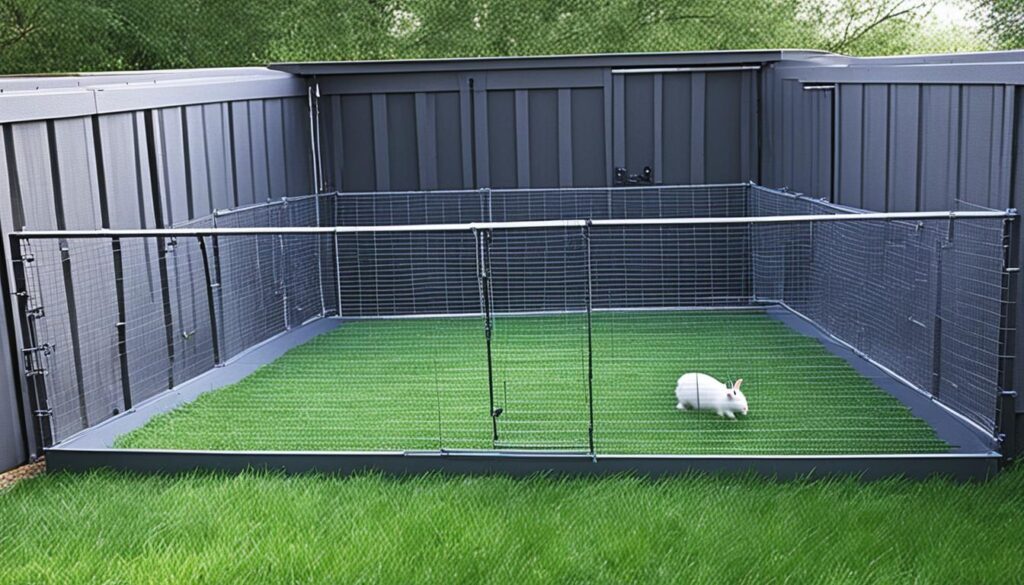
Rabbits also require daily exercise time, either in a designated area or by allowing them to free-roam in a rabbit-proofed space. This exercise is essential for their physical and mental well-being.
By providing a spacious enclosure, you create an environment that promotes your rabbit’s natural behaviors and allows them to stay healthy and happy.
| Enclosure Type | Dimensions |
|---|---|
| Traditional Rabbit Cage | Often too small |
| Pet Exercise Pen | Provides ample space for movement |
| Large Dog Crate | Offers room for exploration |
Pairing Rabbits Together
Rabbits are social creatures that thrive in the companionship of their own kind. Bonding rabbits not only provides them with a playmate but also enhances their overall well-being. The best way to pair rabbits together is by neutering both males and females, as it increases the likelihood of successful bonding, regardless of their sex.
Introducing rabbits should be done gradually and under supervision to ensure a smooth transition. It’s recommended to introduce them in an unfamiliar area, such as a neutral space, which minimizes territorial conflicts. This approach allows rabbits to establish their hierarchy and build familiarity, leading to a stronger bond.
When introducing rabbits, keep a close eye on their behavior. It’s natural for rabbits to display initial hesitation, posturing, and even minor scuffles as they establish their roles within the relationship. However, if aggression or severe fighting occurs, separate them immediately and seek guidance from a rabbit-savvy veterinarian or animal behaviorist.
Bonding rabbits can be a gradual process, taking weeks or even months. Each rabbit has a unique personality, and it’s essential to let them set the pace. Be patient and give them time to adjust and form a bond naturally.
Benefits of Rabbit Companionship
Rabbit companionship offers numerous benefits for these social creatures:
- Physical and Mental Stimulation: Bonded rabbits engage in play, grooming, and other social behaviors, providing mental enrichment and keeping them physically active.
- Emotional Support: Companionship reduces stress and anxiety, making rabbits feel more secure and content.
- Behavioral Balance: Bonded rabbits exhibit more balanced behavior, as they have a companion to communicate and interact with.
- Mirror Natural Behavior: In the wild, rabbits live in large groups, and companionship allows them to display their natural behaviors within a domestic setting.
Remember, bonding rabbits requires time, effort, and patience. But the rewards of witnessing a strong and loving bond between your rabbits make it all worthwhile.
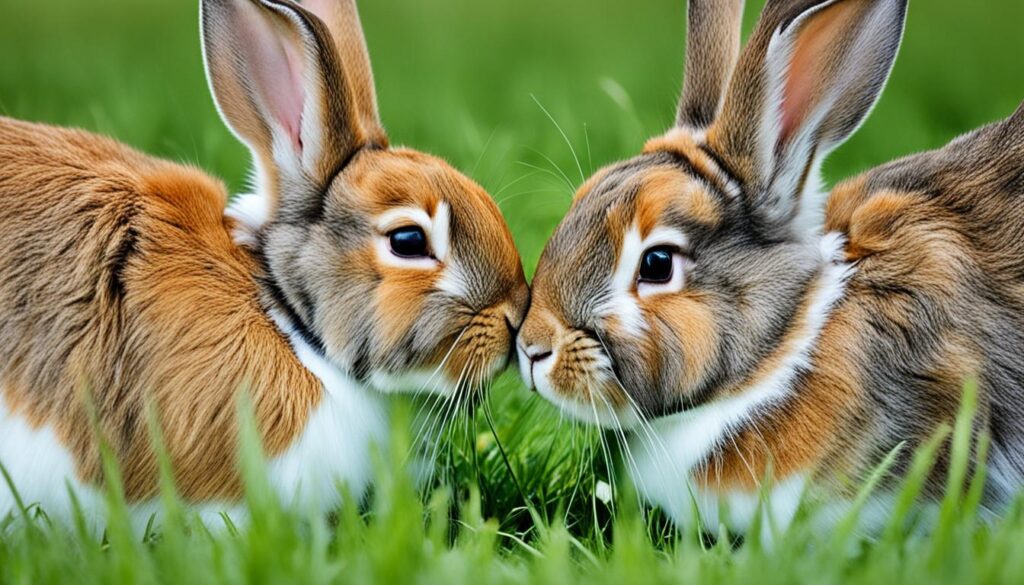
| Steps for Bonding Rabbits | Tips for Successful Bonding |
|---|---|
| 1. Neuter both rabbits before attempting to bond them. | 1. Choose a neutral space for their initial meetings. |
| 2. Introduce rabbits through a barrier, such as a pen or gate, allowing them to see and sniff each other without direct contact. | 2. Monitor their behavior closely during initial encounters to ensure safety. |
| 3. Gradually increase their interaction time, supervising to prevent fights or injuries. | 3. Offer treats and positive reinforcement during their interactions to build positive associations. |
| 4. Allow supervised, controlled physical contact between the rabbits, gradually increasing the duration and frequency. | 4. Be patient and give them time to establish their hierarchy and bond naturally. |
| 5. Seek professional guidance if serious aggression or fighting occurs. |
Understanding Rabbit Behavior
Rabbits have unique behaviors that can vary from breed to breed. It’s important to give them time to adjust to their new environment and develop trust with their human family. When rabbits feel comfortable, they may groom their owners by licking or nibbling. Understanding their behavior helps create a stronger bond between rabbits and their human companions.
One fascinating behavior of rabbits is their instinctual grooming behavior. Rabbits are naturally clean animals and will groom themselves regularly. However, when rabbits trust their owners, they may also groom them as a sign of affection. This grooming behavior is a bonding experience that strengthens the relationship between rabbits and their caregivers.
It’s important to note that grooming is a sign of trust and comfort. When a rabbit grooms its owner, it’s a gesture of acceptance and friendship. Rabbit owners should appreciate and reciprocate this grooming behavior by providing gentle petting and affection.

| Rabbit Behavior | Description |
|---|---|
| Bonding Behavior | Rabbits bond with their human companions through mutual trust and grooming. |
| Trust Building | Time, patience, and positive interactions help rabbits develop trust with their owners. |
| Comfort Grooming | When rabbits feel comfortable, they may groom their owners as a sign of trust and affection. |
“Grooming is a bonding experience between rabbits and their caregivers. It reinforces the trust and connection they share.” – Rabbit Behavior Expert
Understanding rabbit behavior is key to building a strong bond with these delightful pets. By nurturing trust and reciprocating their grooming gestures, rabbit owners can develop a deep and meaningful connection with their furry companions.
Bunny-Proofing Your Home
Before allowing your rabbit to free-roam, it’s crucial to ensure their safety by bunny-proofing your home. By taking the necessary precautions, you can create a secure environment that minimizes the risk of accidents and allows your rabbit to explore and exercise without harm.
One of the first steps in rabbit-proofing your home is securing electrical cords. Rabbits are known to chew on cords, which can be dangerous and potentially lead to electrocution. Use cord protectors or cover them with PVC piping to prevent your rabbit from accessing them.
Another important aspect of rabbit-proofing is eliminating household hazards. Remove any toxic plants from your rabbit’s reach, as many common houseplants can be harmful if ingested. Research pet-safe plants or create barriers to prevent access to plants that may be toxic to rabbits.
Additionally, identify and block off any small spaces where your rabbit could get stuck. Rabbits are curious creatures and may try to squeeze into tight spots, which can lead to injury or entrapment. Use baby gates or create barriers to prevent access to these areas.
Creating a safe environment for your rabbit is essential for their well-being. By bunny-proofing your home, you can provide a space where your rabbit can freely explore, play, and exercise without the risk of harm.

| Hazards | Safety Measures |
|---|---|
| Electrical cords | Use cord protectors or cover cords with PVC piping. |
| Toxic plants | Remove toxic plants or create barriers to prevent access. |
| Small spaces | Identify and block off any small spaces where your rabbit could get stuck. |
Litter Training and Grooming
Litter training is an essential aspect of rabbit care. By providing a designated litter box and using positive reinforcement techniques, you can teach your rabbit to eliminate waste in the appropriate area. This not only helps maintain cleanliness in your home but also promotes good hygiene for your pet. When starting litter training, place your rabbit’s litter box in a quiet and accessible location within their enclosure. Use rabbit-safe litter materials such as paper-based or wood-based pellets. Introduce your rabbit to the litter box after meals or playtime as they are more likely to need to use it at these times. If accidents occur, clean the soiled area thoroughly and consider using odor-neutralizing products to discourage repeated marking.
Grooming is another important aspect of rabbit care. Regular brushing helps prevent matting and keeps your rabbit’s coat clean and healthy. Depending on your rabbit’s breed and coat length, you may need to groom them daily or a few times a week. Use a soft brush or a comb specifically designed for rabbits to remove loose fur and prevent hairballs. Grooming sessions also provide an opportunity to check your rabbit’s overall health and well-being. Look for any signs of illness, such as changes in appetite, behavior, or the presence of parasites. If you notice any abnormalities, consult a veterinarian for further evaluation and treatment.

“Regular grooming helps keep your rabbit’s coat in top condition, preventing mats and promoting a healthy shine. It’s also a great bonding activity between you and your furry friend.” – Dr. Sarah Miller, Rabbit Specialist
Tips for Effective Litter Training:
- Consistency is key: Place your rabbit’s litter box in the same spot consistently to establish a routine.
- Reward positive behavior: Offer treats or praise when your rabbit successfully uses the litter box.
- Patience and persistence: Litter training may take time, so be patient and reinforce good habits consistently.
Tips for Effective Grooming:
- Start grooming at an early age to familiarize your rabbit with the process.
- Use gentle, calm movements to avoid stressing your rabbit during grooming sessions.
- Regularly trim your rabbit’s nails to prevent overgrowth and discomfort.
By incorporating litter training and grooming into your rabbit care routine, you can ensure a clean and comfortable living environment for your beloved pet.
| Litter Training | Grooming |
|---|---|
| Teaches rabbits to eliminate waste in designated areas | Prevents matting and keeps the coat clean |
| Promotes cleanliness in the home | Allows for regular health checks and parasite detection |
| Helps establish a routine for your rabbit’s bathroom habits | Strengthens the bond between the owner and the rabbit |
Veterinary Care for Rabbits
In order to ensure the well-being of your rabbit, it is crucial to provide regular veterinary care. Just like any other pet, rabbits require check-ups to monitor their health and address any concerns that may arise. Additionally, being aware of the signs of illness and seeking prompt veterinary care is essential for maintaining their overall well-being.
If you notice any changes in your rabbit’s appetite, behavior, or droppings, it could be an indication of an underlying health issue. These changes should not be ignored; instead, it is important to seek veterinary care promptly to address any potential problems.
Rabbits are prone to certain health issues, including dental problems and gastrointestinal stasis. Dental problems can develop when their teeth become overgrown or misaligned, leading to difficulties in eating and potential infections. Gastrointestinal stasis, on the other hand, is a condition that affects the normal movement of food through the digestive system, resulting in a slowdown or complete stoppage of the digestive process.
Regular veterinary check-ups and examinations can help detect these health issues early on, allowing for timely intervention and treatment. Your veterinarian will be able to assess your rabbit’s overall health, perform dental evaluations, and provide guidance on maintaining proper nutrition and hygiene.
Signs of Illness to Look Out For:
- Loss of appetite or change in eating habits
- Unusual or excessive lethargy
- Changes in behavior, such as aggression or excessive hiding
- Abnormal droppings, including diarrhea or constipation
- Signs of pain or discomfort, such as teeth grinding or hunching
- Difficulty breathing or nasal discharge
- Skin abnormalities or lumps
If you observe any of these symptoms in your rabbit, it is crucial to contact your veterinarian immediately. Timely intervention can make a significant difference in the outcome and treatment of any potential health issue.
Your veterinarian will also be able to provide guidance on preventive care measures, such as vaccinations and parasite control, that are important for your rabbit’s well-being. By working together with your veterinarian, you can ensure that your rabbit remains healthy, happy, and thriving.
Caring for Baby Bunnies
When it comes to caring for baby bunnies, special attention must be given to their delicate needs and nutritional requirements. Baby rabbits, also known as kits, rely on their mother’s milk for their initial weeks of life. This essential nourishment provides them with the necessary nutrients and antibodies to support their growth and development.

As baby bunnies grow, a gradual transition to solid foods is vital to ensure their overall health.
Feeding Baby Bunnies
At around 8 weeks old, baby bunnies can start consuming other types of food in addition to their mother’s milk. It’s important to introduce a balanced diet that includes hay, fresh greens, and pellets. These food sources provide the essential nutrients necessary for their growth and promote good digestion.
| Food | Benefits |
|---|---|
| Hay | Aids in digestion and dental health |
| Fresh greens | Provides additional nutrients and variety |
| Pellets | Serves as a nutritional supplement in limited quantities |
It’s essential to monitor the baby bunnies’ acceptance and tolerance of these new foods. Gradually introduce them to ensure a smooth transition and avoid digestive issues.
Creating a Warm and Safe Environment
Providing a warm and safe environment is crucial for the well-being of baby bunnies. Maintain an ambient temperature between 65-75°F (18-24°C) to prevent them from getting too cold. Make sure they have access to a secure and comfortable nesting box or area where they can rest and feel secure. Proper socialization is also important during this stage to ensure they develop trust and familiarity with humans.
Remember, each baby bunny is unique, and their nutritional needs may vary. It’s always recommended to consult with a veterinarian experienced in rabbit care to ensure you’re providing the best care for these adorable little creatures.
Understanding Rabbit Lifespan
Rabbits are delightful companions that bring joy and happiness into our lives. However, it’s important to remember that they are a long-term commitment. The average lifespan of a rabbit is around 8 to 12 years, and in some cases, they can live even longer with proper care and attention.
Caring for a rabbit throughout their life requires dedication and commitment. As they age, they may develop specific needs that require additional care and support. By understanding the aging process and making necessary adjustments, you can ensure a comfortable and happy life for your beloved rabbit.
Caring for Aging Rabbits
As rabbits age, it’s essential to closely monitor their health and well-being. Regular check-ups with a veterinarian experienced in rabbit care are crucial to catch any potential issues early on. They can provide valuable guidance and recommend appropriate treatments or interventions to ensure your rabbit’s comfort and quality of life.
In addition to regular veterinary care, providing a comfortable living environment is paramount for aging rabbits. Ensure they have a spacious enclosure that allows for easy movement and plenty of resting areas. Pay attention to their bedding, ensuring it’s soft and cozy to alleviate any joint stiffness or discomfort.
As rabbits age, their dietary needs may change. Consult with your veterinarian to determine the best diet for your aging rabbit, considering their specific health conditions and any potential dietary restrictions. Adjusting their diet to include more soft or moist foods may be necessary to accommodate any dental issues or reduced appetite.
Exercise remains essential for aging rabbits, even though their activity level may decrease. Encourage gentle movement and provide opportunities for light exercise tailored to their capabilities. This can help maintain muscle tone and prevent stiffness or immobility.

Remember, aging rabbits require extra care, patience, and love. Spend quality time with them, providing gentle interactions and reassurance. Offer plenty of mental stimulation with toys and activities appropriate for their age. Engaging in grooming sessions can also help promote bonding and physical comfort.
By prioritizing their health, comfort, and overall well-being, you can ensure that your aging rabbit enjoys their golden years to the fullest. With your dedicated care, they will continue to bring you joy and companionship throughout their entire life.
Outdoor vs. Indoor Rabbit Housing
Rabbits can be housed both indoors and outdoors, offering different advantages and considerations based on personal preferences and circumstances.
Indoor housing provides better control over the rabbit’s environment and ensures their safety. By creating a bunny-proofed space, you can allow your rabbit to roam freely and express their natural behaviors. This space should have safe hiding spots, tunnels, and toys to keep your indoor rabbits mentally stimulated and physically active.
Indoor housing allows for a close bond between the rabbit and their human companions. Being near humans helps your rabbit feel secure, increases their social interaction, and strengthens the trust and relationship between you and your furry friend.
For indoor housing, it’s important to invest in a secure enclosure where your rabbit can rest and sleep. This enclosure should have ample space for their comfort, along with cozy bedding and access to fresh water and hay at all times.
On the other hand, outdoor housing offers rabbits the opportunity to enjoy natural surroundings and fresh air. An outdoor playpen, set up in a safe and grassy area, provides rabbits with space to explore, hop, and graze on fresh grass. However, outdoor housing requires careful consideration of factors such as climate, predators, and available space.
Outdoor housing allows rabbits to experience the sights and sounds of nature, stimulating their senses and providing a more enriching environment.
When setting up an outdoor playpen, make sure it is escape-proof and predator-proof to ensure your rabbit’s safety. Providing shade and shelter from extreme weather conditions is essential, and always supervise your rabbit’s outdoor activities to prevent accidents or escapes.
Comparison of Indoor and Outdoor Rabbit Housing
| Indoor Housing | Outdoor Housing |
|---|---|
| Allows better control over the environment and safety | Offers a more natural and stimulating environment |
| Promotes a close bond between rabbits and their human companions | Provides exposure to fresh air and natural surroundings |
| Requires proper bunny-proofing and a secure enclosure | Demands careful consideration of climate, predators, and space |
| Allows for year-round housing without weather concerns | Requires shelter and protection from extreme weather conditions |
Ultimately, the housing option for your rabbit should prioritize their well-being, comfort, and safety. Whether you choose indoor or outdoor housing, ensuring sufficient space, mental stimulation, and social interaction are crucial for a happy and healthy furry companion.
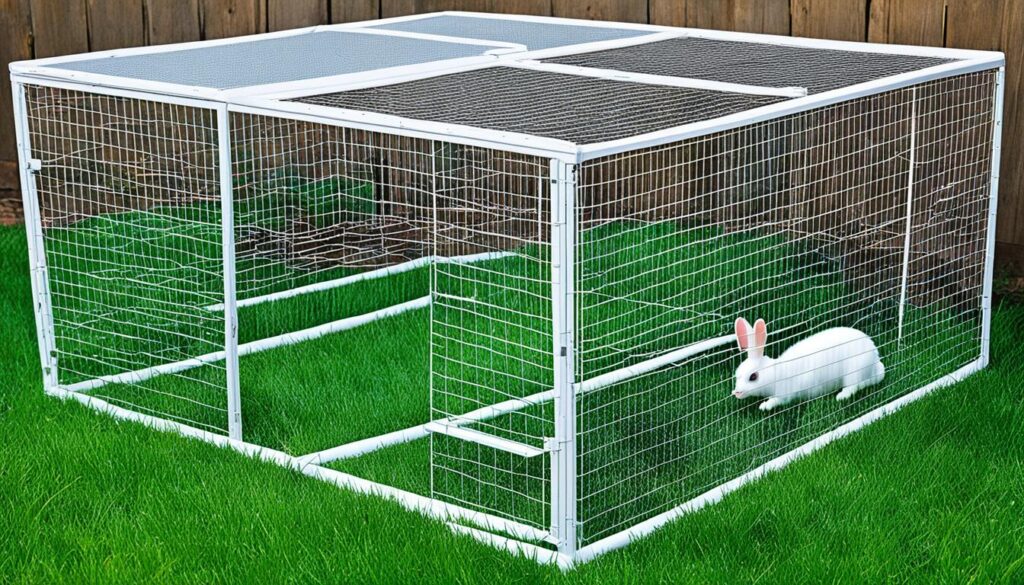
Rabbit Enrichment and Exercise
Rabbits are active animals that require mental stimulation and daily exercise to maintain their physical and mental well-being. Providing them with appropriate toys and interactive items is essential to keep them engaged and prevent boredom.

Toys for rabbits can vary, but some popular options include chew toys, puzzle toys, and tunnels. Chew toys not only help to keep their teeth healthy by providing a natural outlet for their chewing instincts, but they also provide mental stimulation as rabbits enjoy exploring and interacting with objects in their environment.
Puzzle toys, such as treat-dispensing toys, challenge rabbits to problem solve and work for their treats, which keeps their minds active and engaged. These toys are a great way to stimulate their natural foraging behavior and provide hours of entertainment.
Rabbits also love tunnels, as they mimic the burrows they would create in the wild. Tunnels offer a place to hide, run through, and explore, encouraging a healthy level of physical activity and mental stimulation.
In addition to toys, it’s important to give your rabbit opportunities for exercise. Providing a safe and secure space for them to roam freely, such as a rabbit-safe room or a playpen, allows them to stretch their legs and satisfy their natural instincts. You can also set up obstacle courses using boxes and furniture to create a fun and challenging environment.
Regular exercise not only keeps rabbits physically fit but also helps prevent obesity and contributes to their overall well-being. By providing mental stimulation and exercise through toys and play, you can ensure that your rabbit leads a happy and healthy life.
Common Rabbit Health Issues
Keeping your rabbit healthy is essential for their well-being and happiness. Like any other pet, rabbits can experience health issues that require attention and care. By understanding common rabbit health issues and taking preventive measures, you can help ensure a long and healthy life for your furry friend.
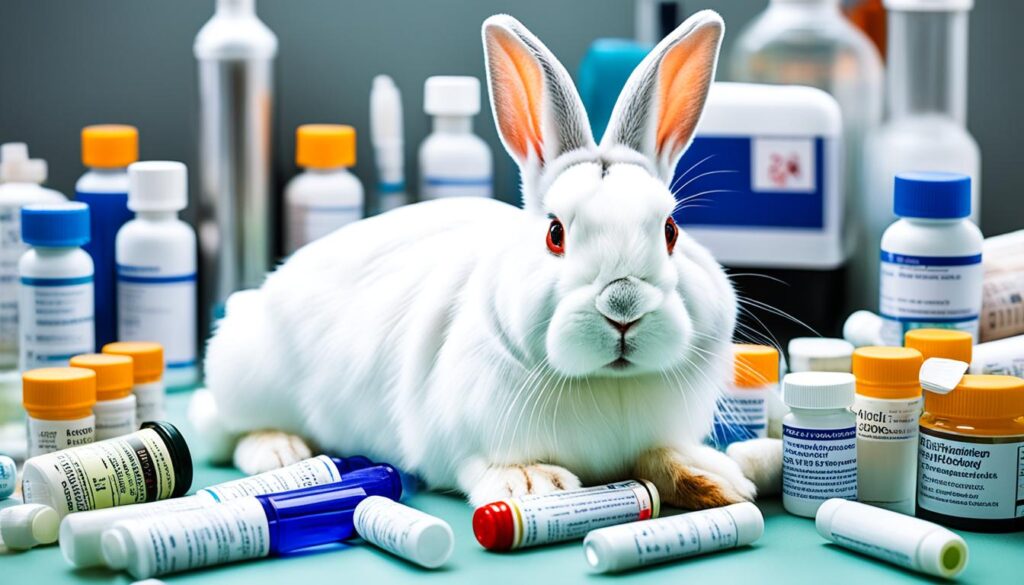
- Dental Problems: Rabbits’ teeth continuously grow, and if not properly worn down through chewing, they can develop dental issues. Regularly provide your rabbit with hay and chew toys to promote dental health.
- Gastrointestinal Stasis: This condition occurs when a rabbit’s digestive system slows down or stops working. It can be caused by factors such as diet, stress, or lack of exercise. Signs of gastrointestinal stasis include decreased appetite, bloating, and fewer or smaller droppings. If you notice these symptoms, seek veterinary care immediately.
- Respiratory Infections: Rabbits are susceptible to respiratory infections, which can be caused by bacteria, viruses, or environmental factors. Symptoms may include sneezing, coughing, nasal discharge, and difficulty breathing. Prompt veterinary treatment is necessary to prevent complications.
- Parasites: Rabbits can be affected by external parasites like fleas, ticks, and mites, as well as internal parasites like worms. Regularly check your rabbit’s fur and skin for any signs of infestation, such as itching, hair loss, or visible parasites. Consult your veterinarian for appropriate treatment.
Preventive Care for Your Rabbit’s Health
Preventing health issues in rabbits is essential for their overall well-being. Here are some preventive care measures you can take:
- Provide a Balanced Diet: A nutritious diet is crucial for a rabbit’s health. Offer a variety of fresh hay, leafy greens, and a limited amount of pellets. Avoid giving them foods that are harmful to their digestive system, such as chocolate, caffeine, or sugary treats.
- Maintain a Clean Environment: Regularly clean your rabbit’s enclosure to prevent the buildup of bacteria or parasites. Provide fresh water daily and ensure your rabbit has a clean and comfortable space to rest and play.
- Monitor Behavior and Appearance: Pay attention to any changes in your rabbit’s behavior, appetite, or droppings. Monitor their weight, fur quality, and overall appearance. Any noticeable alterations may indicate an underlying health issue that requires veterinary attention.
- Regular Veterinary Check-ups: Schedule regular check-ups with a rabbit-savvy veterinarian to ensure your rabbit’s health is monitored and any potential issues are addressed early. Vaccinations and spaying/neutering are also important to prevent certain diseases and unwanted behaviors.
Remember, prevention is always better than cure when it comes to your rabbit’s health. By providing proper care, a well-rounded diet, and a clean environment, you can minimize the risk of common health issues and maximize the potential for a happy and healthy rabbit companion.
Tips for Training and Bonding with Your Rabbit
Training and bonding with your rabbit is a rewarding experience. By using positive reinforcement techniques, you can teach your rabbit commands and tricks while strengthening your relationship. Here are some valuable tips to help you with rabbit training and bonding:
1. Start with Trust
Building trust is essential for successful training and bonding. Spend quality time with your rabbit, gently stroking and petting them to create a sense of security. Avoid sudden movements or loud noises that may scare your rabbit. Patience is key in earning their trust.
2. Use Positive Reinforcement
Rabbits respond well to positive reinforcement. Use rewards, such as small treats or praise, to encourage desired behaviors. When your rabbit follows a command or performs a trick correctly, immediately reward them. This will reinforce their understanding and motivate them to continue learning.
3. Be Consistent
Consistency is crucial during the training process. Use the same signals or verbal cues for each command. Establish a regular training routine to help your rabbit understand what is expected of them. Keep training sessions short and frequent, as rabbits have shorter attention spans.
4. Understand Individual Personality
Each rabbit has a unique personality, so it’s important to understand what motivates and excites your bunny. Observe their behavior and adapt your training methods accordingly. Some rabbits may respond better to food rewards, while others may prefer playtime as a reward.
5. Gradual Progression
Training should be a gradual process. Begin with basic commands, such as “come” or “sit.” As your rabbit becomes more comfortable and confident, you can introduce more complex tricks. Remember to break down each trick into smaller steps and reward progress along the way.
6. Bonding Activities
Bonding with your rabbit goes beyond training. Spend quality time together engaging in activities that strengthen your bond. This can include gentle grooming sessions, playtime with toys, or simply relaxing together in a peaceful environment.
7. Seek Professional Help
If you encounter specific challenges or require additional guidance, consider seeking help from a professional rabbit trainer or behaviorist. They can provide expert advice tailored to your rabbit’s individual needs.
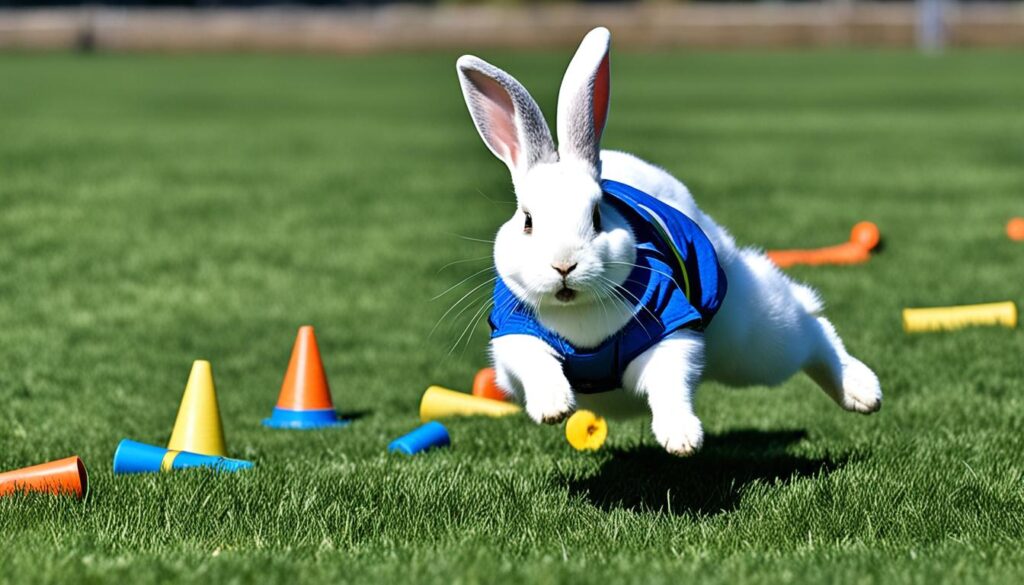
| Training Tips | Bonding Tips |
|---|---|
| Start with trust | Establish a routine for bonding activities |
| Use positive reinforcement | Be patient and spend quality time together |
| Be consistent in your training methods | Understand and respect your rabbit’s individual personality |
| Progress gradually with training | Engage in gentle grooming sessions |
| Seek professional help if needed | Play together with interactive toys |
Conclusion
Caring for a rabbit requires dedication, knowledge, and a genuine love for these adorable creatures. By understanding their unique needs, providing a healthy diet, spacious enclosure, mental stimulation, and veterinary care, you can ensure the well-being and happiness of your rabbit companion. The bond you form with your rabbit will be a deeply rewarding experience, making all the effort worthwhile. Embrace the journey of caring for and training your rabbit, and enjoy the unconditional love and joy they bring into your life.
Rabbits make great pets for individuals and families alike. They are not only charming and cute, but they also have distinct personalities that can bring endless joy to your home. However, it’s important to remember that rabbits require commitment and responsibility. Their care involves providing a suitable living environment, meeting their nutritional needs, and ensuring their health and well-being.
Whether you choose to have an indoor or outdoor rabbit, adopting or purchasing a rabbit is a long-term commitment that requires your time, patience, and attention. Through positive reinforcement training, you can teach your rabbit commands and tricks, further strengthening the bond between you. With proper care and training, your rabbit can become a cherished member of your family.




